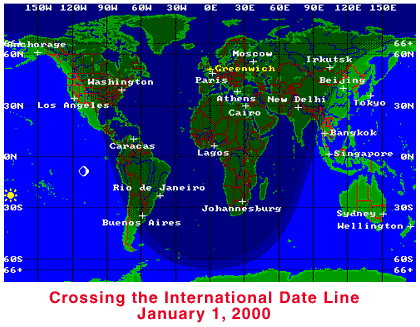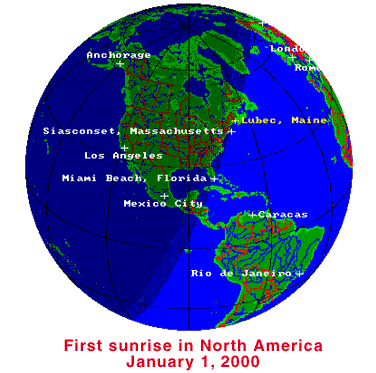
Y E A R 2 0 0 0 A N D B E Y O N D
|
It's January 1st of the year 2000. You wake up from the terrific party you attended the night before and find that your clock has stopped. You try to make yourself some microwaved coffee, but your microwave unit just beeps and does nothing. Frustrated, you decide to drive to the doughnut shop. There are especially long lines extending in to the street and you soon learn that the cash registers do not work and the shop is having to make change manually. Later, you learn that it is virtually impossible to make a phone call and a friend tells you that the banks have closed and there are no operational ATM machines. And this is just the start of what is perhaps the worst day of your life. We all know about the computer glitches that are expected to occur when the year 2000 arrives. We have been told that computers which code the year by using the last two digits will "go haywire" when these digits become "00." And many of these problems have been addressed as the millennium nears. But, as systems analysts look more deeply into the Y2K problem, they are finding that these software solutions are just not working. The problem is something called the "embedded chip." In most modern cars, as you start the engine, a number of tests are conducted. Is there sufficient battery power? Is the anti-lock brake system working? Are your seatbelts fastened? These types of safety checks are helpful and are controlled by pre-programmed chips, mini-computers that measure any number of parameters before allowing your vehicle to start. If there is a problem, you will likely get a warning light. In more complex systems, this same automated check list is carried out by these embedded chips. In the case of many industrial components, however, a failure not only signals a warning light but prevents the unit from operating.
 Embedded chips are usually ROM, or "Read Only Memory" chips which cannot be re-programmed. They were routinely placed in telephone switching machines, computers and a host of complex equipment in use by banks, the military and health industry-- situations which demanded that units not be allowed to "power up" if certain conditions or tests of their parts proved dangerous to either the equipment itself of the person using it. The chips store information in "logs" which usually compare data to the previous parameters of the day before, or the date the system test was last performed. It is these "chips" that are now wreaking havoc with system engineers all over the globe. The Pentagon recently announced that many of the programs involved with our national defense were subject to Y2K errors. Since these programs were installed and written decades ago, in the midst of the Cold War, they were mostly executed in a computer language called COBOL. Most of the people who used this archaic language are in their 70's and long retired. The government has made an effort to recruit COBOL programmers from retirement to fix, where possible, the programs effected by year "00." These programmers are earning up to $1,000 per day and are kept busy. A source close to the problem of military compliance recently proposed a frightening scenario. The Strategic Air Command has in place certain programs that are designed to run when communication with the main command has been knocked out. This would only happen if a first strike were to destroy the command center. Many of the missile routines, assuming that this failure indicates a first strike has occurred, will automatically deploy a sally of nuclear missiles from silos around the U.S. That's the bad news. The good news is that many of the internal components inside these missiles have "embedded chips" deep within their circuitry that, even if launched, will likely fail. Many of the manufacturers of these components with "embedded chips" are no longer in operation and no support help is available. The problem gets really shaky when you consider the deteriorating state and lack of upgrading for Y2K that has been done to ex-Soviet systems, now in the hands of Russian satellites countries! The U.S. Military has offered assistance to the Russians but even if the software glitches are resolved in time, the "embedded chip" problem may be far too complex and expensive to resolve.
this failure indicates a first strike has occurred, will automatically deploy a sally of nuclear missiles from silos around the U.S. That's the bad news...
In the U.S., the Treasury has recently downplayed the problem with banks and financial records, nevertheless, the mint has begun printing $50 billion in new bills to be distributed later next year as the anticipated "run of the banks" ensures in November and December of 1999. Details of military contingencies are being classified in America, but our closest neighbor, Canada, has publicly announced its fears and plans to combat riots and power outages believed possible by "embedded chips" in electrical switching stations and power plants.
The Canadian Armed Forces have been ordered to spend the next 14 months preparing for what could be their biggest peacetime deployment -- tens of thousands of troops spread across the country and frigates standing by in major ports-- in case computer problems in 2000 bring civil chaos. The army is studying everything from the number of flashlights and batteries it will need if power is out for weeks to whether military air-traffic-control field equipment should be set up at civilian airports.
Logistics officers are plotting where to position vehicles, fuel, tents, cots, ration packs and other supplies. Signals officers are trying to figure out how to keep high government officials in communication if commercial systems fail. Rules for the use of force are being drafted should soldiers have to make arrests or back up police dealing with riots and looting.
No one knows whether a common programming flaw -- a seemingly small matter of dealing with dates beyond 1999-- will cause cascading failure in the world's computer systems, knocking out in the dead of a Canadian winter equipment that runs everything from traffic lights to nuclear reactors. It could turn out to be one of history's great anticlimaxes, but the armed forces are taking no chances.
Navy captains have been told their ships may have to be docked to serve as garrisons, power plants, field hospitals and soup kitchens. On land, the official worst-case scenario would have 32,000 soldiers, including volunteer reservists, living and working in the field.
When "00" arrives, some computers may think it is 1900 or some other base year. Some may be uncertain of the year or even the day of the week. (Dec. 31, 1999, is a Friday; Jan. 1, 1900, was a Monday. That does not compute.) They may act strangely or shut down, paralyzing complex systems.
Or maybe not. The Year 2000 problem (Y2K for short) has been called both a death sentence for industrial civilization and a fraud perpetrated by computer types. Whatever it is, billions of dollars and millions of hours of work will have been lavished on it before the end of next year.
 What is the first place on each continent where the Sun rises on January 1, local time?
At 0 hours (Universal Time) UT the Sun is rising along a line that runs from about 650 km east of Kerguelen Island in the Indian Ocean to about 640 km east of Amsterdam Island, through the Nicobar Islands, up along the Burma-Thailand border, through China, along the China-Outer Mongolia border, along the China-Russia border, through Siberia and out into the Arctic Ocean just north of the Poluostrov peninsula. All places along this line will experience sunrise simultaneously at 0 hours UT on 2000 or 2001. There is no unique "first sunrise" location.
 The first place where the Sun will rise in the new millennium, local time, will be on the International Date Line, all of which is in the Pacific Ocean. Even though the line makes some zigzags to the east, the place on the line where the Sun will rise first is far south, near the Antarctic Circle, where the line is intersected by the terminator (day/night line). Here, the Sun dips just below the horizon and then rises again almost immediately at midnight local time. The longitude is 180° E exactly, and we take the local time to be 12 hours ahead of UT. The southern limit to the terminator is at latitude 66° 3' S on January 1, 2000 and 66° 7' S on January 1, 2001. Both of these locations are in the extreme southern part of the Pacific Ocean with no land nearby.
| |||||